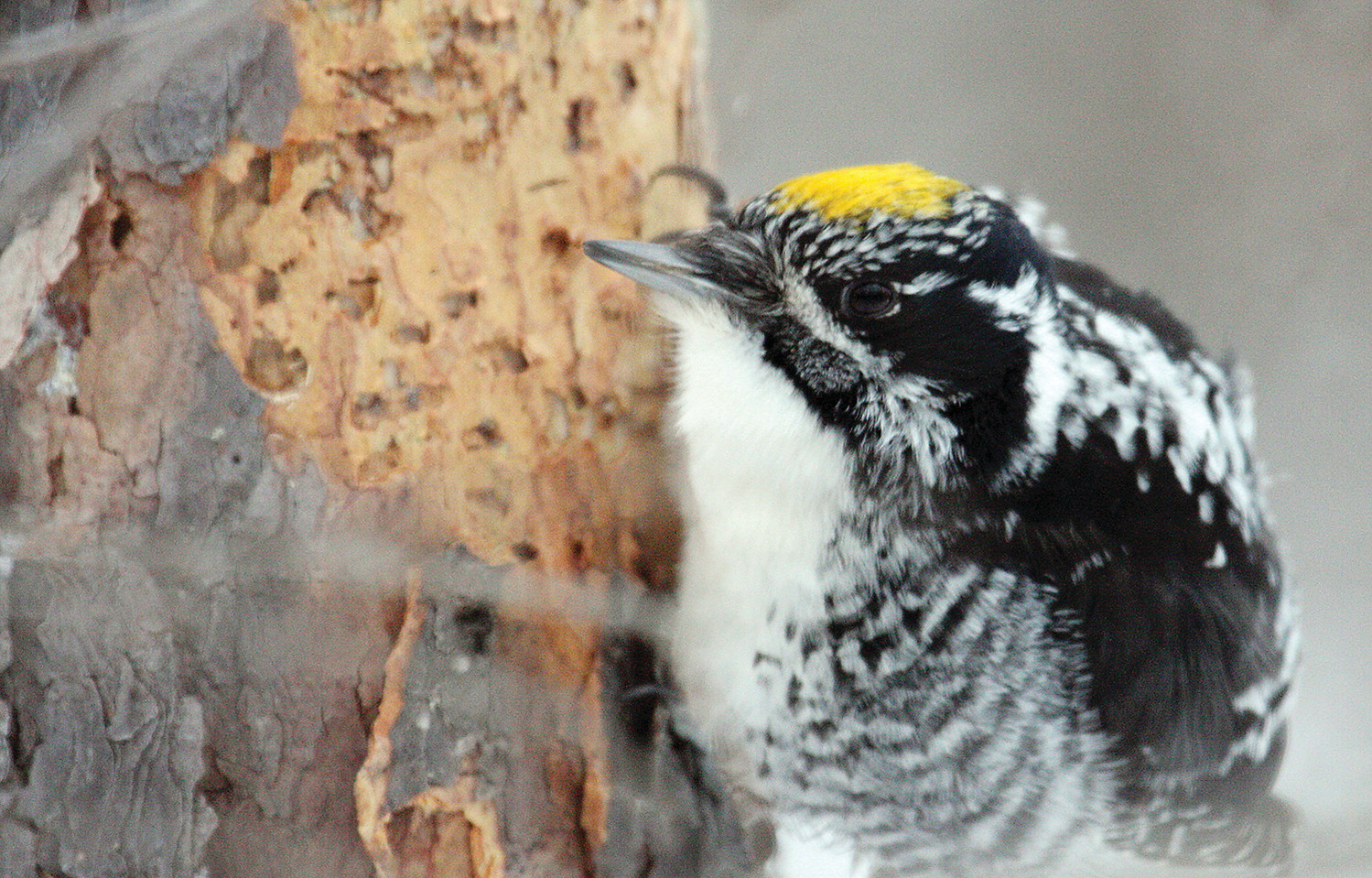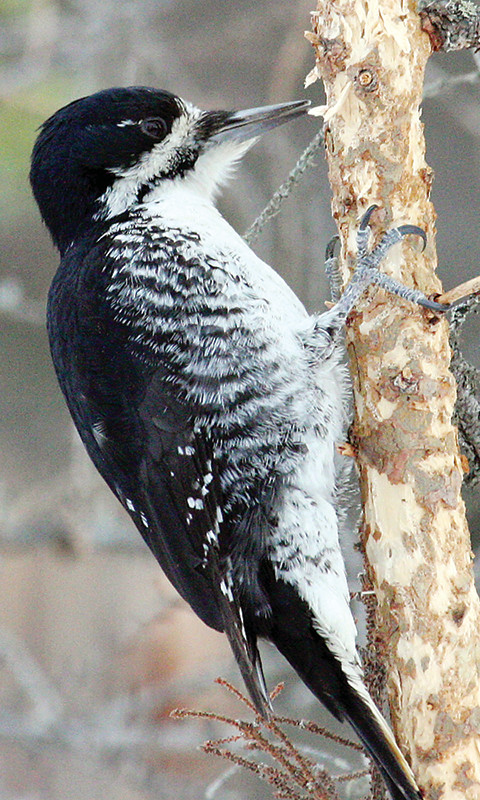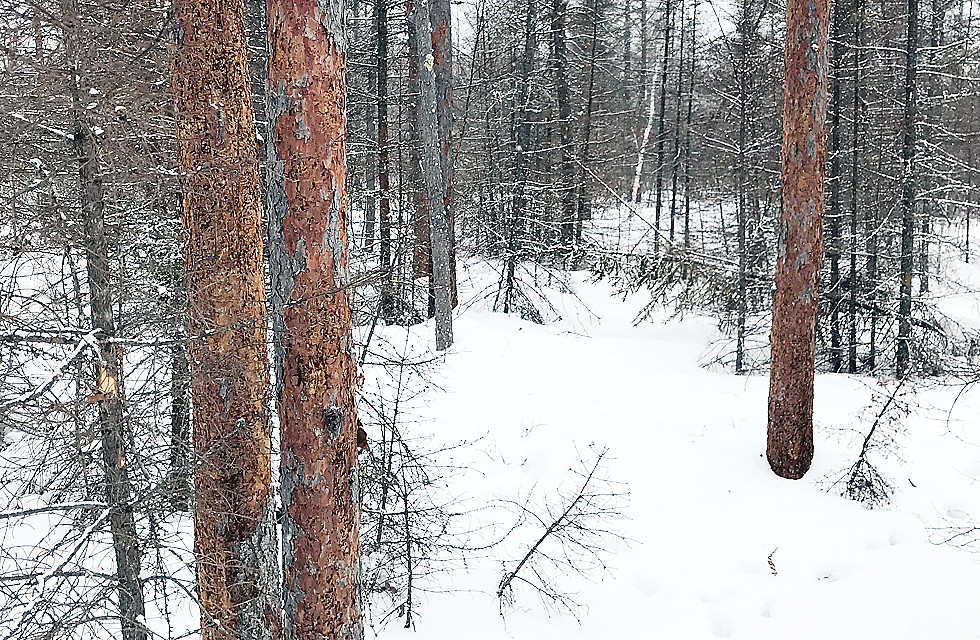Support the Timberjay by making a donation.
An enclave of three-toeds
These boreal forest woodpeckers are unusual as well as uncommon
You have to listen closely to hear an American three-toed woodpecker at work. In contrast to the noisy flamboyance of many other species of woodpeckers, this rare woodpecker prefers the quiet life.
A pileated or hairy woodpecker may be happy to pound and drill noisily on trees and logs— usually the louder the better. But not so for the three-toed woodpeckers. There are actually two species of three-toed woodpeckers, the American and the somewhat more common black-backed woodpecker, both of which are found here in the North Country.
These two species of woodpeckers are known as “three-toed” to distinguish them from most other woodpeckers, which have four toes— two in front and two in back.
The three-toed, over the course of time, lost one of the back toes and effectively uses all three of its toes as “front toes” when clinging to the trunks of trees. You can see that in the photo at right.
You’re unlikely to see either of these birds at your suet feeder. Unlike our more common woodpeckers, which readily come to feeders, the three-toeds are specialists that rarely can be coaxed from their remote forest habitats. These woodpeckers make their living by softly flaking loose bark off of trees, most often spruce and jack pine. These are two species largely limited to the boreal forest or coniferous woods high in the Rockies, and they feed on the bark beetles that feed on the cambium, found just below the bark, of dead or dying conifers. Flaking off the bark exposes the beetles and their larvae, and the woodpeckers use their sticky tongues to grab a meal.
You can always tell when one of these woodpeckers has been at work. Fresh flakes of bark litter the ground, and you almost invariably look up to see the trunk of a spruce or jack pine nearly stripped bare.
The population of these two species ebbs and flows across the landscape, depending mostly on food supply. The American three-toed, in particular, appears to follow natural disaster across the vast taiga, showing up in the wake of forest fires or insect outbreaks. Wherever large numbers of dead spruce, or jack or lodgepole pine can be found, three-toed woodpeckers won’t be far behind, flaking off the remaining bark looking for food.
That’s exactly what brought a small population of these rare birds to the woods near our house recently. When beavers plugged up a flowage along the edge of the Lost Lake Swamp four years ago, they flooded about 15 acres, including about five acres of regenerating black spruce and tamarack. The flooding soon killed the trees, which attracted wood-boring insects, and eventually the three-toed woodpeckers, both American and black-backed.
I discovered them a couple weeks ago, on one of my many forays in the woods. I’m always on the lookout for the unusual whenever I’m out and as I neared this stand of dead trees, I could see the telltale signs of three-toed woodpecker activity. Literally hundreds of trees were in various stages of being stripped bare of their bark. As I stopped and listened, I could hear the soft tapping of three-toeds at work— in every direction. After more exploration of the site the following day with some friends, we determined there were at least four American three-toeds and an undetermined number of black-backed woodpeckers.
To give you an idea of how rare the American three-toed actually is, these were the first I had ever seen in Minnesota. Only once before, 40 years ago, had I seen one of them, and that was in northern Saskatchewan.
We posted word of the find on a statewide rare bird alert and with the Ely Field Naturalists and soon had people coming from as far away as the Twin Cities and La Crosse, Wis. to see the rare birds. We led two tours to the site this past weekend and everyone was thrilled to get great looks at both species.
The American three-toeds are just slightly smaller than a hairy woodpecker. The black-backed is about the size of a hairy, but is easy to distinguish by its charcoal-black back. The American three-toed can be a bit tougher to distinguish, although the yellow cap on top of the head is a give-away on a male bird. Both the male black-backed and American sport a yellow forehead, which distinguishes them from any other woodpeckers in the North Country. The male hairy and downy woodpeckers sport a red patch on the back of their heads. Females lack the colored patch, which can make them a bit tougher to distinguish from a female American three-toed.
Of course, one of the easiest ways to distinguish a three-toed from a hairy is just by watching its behavior. Hairies are aggressive, noisy, and inquisitive. Three-toeds are quiet and keep to themselves. That’s why you’ll have to be paying attention to find them.











